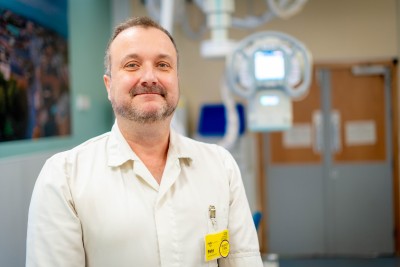
We have more than 35 qualified and highly skilled Radiographers and Assistant Practitioners working at Chesterfield Royal Hospital and the surrounding satellite locations (Buxton Hospital, Whitworth Hospital, and Walton Hospital). The team cover a wide variety of plain film X-ray examinations.
We also provide three mobile fluoroscopy units and Radiographers to provide imaging for our colleagues in Theatres.
The team carry out more than 120,000 examinations per year across the sites.
Chesterfield Royal Hospital X-Ray Department is a training centre for Radiography students and is affiliated with Sheffield Hallam University and the University of Derby.
Chesterfield Royal
8am -8pm 7 days a week for routine outpatient and GP appointments but operating 24 hours a day, 365 days a year for Emergency and Inpatient imaging requirements. Dental cone beam CT is available Monday-Friday 9-5pm.
Whitworth Hospital
Monday to Sunday 8am to 8pm (Bank Holidays 9am-5pm excluding Xmas Day)
Buxton Hospital
Monday- Friday 9am to 5pm
An X-ray examination uses small amounts of ionising radiation (X-rays) to produce images of bones and organs within the human body. With any examination involving X-rays, there is a small risk associated with the exposure, however, in all cases, the benefit of having the examination should outweigh any small risk. This can be discussed in detail with your Clinician or Healthcare Professional undertaking the test.
X-rays are used to produce an image of lungs, bones, or teeth to aid in the diagnosis of conditions/illnesses. X-rays are painless. The X-rays are saved like a photograph, on a computer system called PACS, which is then ready for reporting by a radiologist or specially trained radiographer.
For you to make an informed decision about this referral and to give your consent, it is important for you to be aware of the possible risks.
For further information please see the patient information leaflet- The Risks of a Diagnostic X-Ray Examination
You don't need to prepare for an X-ray
After booking in at the main reception, you will be asked to wait in the main reception waiting room. A member of staff will call out the patient’s name and escort you to a sub-wait area or into a changing room. If applicable to your examination, you may be asked to remove certain clothing or jewellery and change into a hospital gown.
The radiographer or assistant practitioner performing the test (specialist healthcare worker trained to perform X-rays) will explain what is going to happen and what position you need to be in. This is the time to ask any questions you may have. It's important to let us know if you may be or are pregnant.
If your examination includes x-raying between your diaphragm and knees, we will have to ask any one between the ages 12-55 their sex at birth. The answer to this question will determine if any further questions are needed.
The X-ray machine, which looks like a tube containing a large light bulb, will be carefully aimed at the part of the body being examined by the Radiographer. They will operate the machine from behind a screen.
Clear instructions will be provided during the examination.
There is nothing further to do after the x rays have been performed so you will be free to leave.